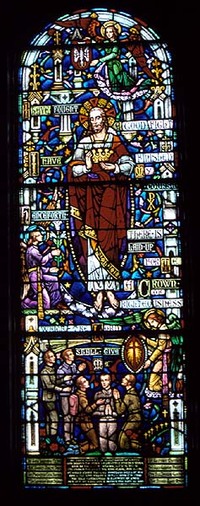MSGC : Featured Windows : Current Window
Featured Windows, May 2004
St. Paul’s Episcopal Church Window
Building: St. Paul's Episcopal Church
City: Jackson
State: Michigan
Some of the more intriguing examples of stained glass windows found in churches and other public buildings are those dedicated to veterans or the war dead. The war memorial window at St. Paul's Episcopal Church in Jackson is dedicated to the lives of eight men who lost their lives in World War II. It juxtaposes biblical imagery with the more worldly representation of soldiers in uniform and a contemporary poetic tribute.
The upper sections of the densely-rendered composition depict a crimson-robed, ascendant Christ with a crown in his hands. There are three angels surrounding him, the Angel of Peace (in green, top right), the Angel of Resurrection (in violet, center left) and the Angel of Sacrifice (in gold, lower right). The text fragments surrounding Christ draw from 2 Timothy 4:7-8: "I HAVE FOUGHT A GOOD FIGHT I HAVE FINISHED MY COURSE HENCEFORTH THERE IS LAID UP FOR ME A CROWN OF RIGHTEOUSNESS WHICH THE LORD SHALL GIVE ME."
In the bottom tier of the window are five young uniformed men in prayer. Next to the rightmost kneeling man are eight small crosses, representing the eight parishioners of St. Paul's Episcopal who lost their lives in World War II, and to whom this window is dedicated. Beneath them is an edited version of the poem "High Flight," by Pilot Officer John G. Magee, Jr. An American pilot serving with the Canadian Air Force, Magee died shortly after composing this poem in 1941. The poem has since sometimes come to be used as an elegy for pilots who die in flight:
Oh! I have slipped the surly bonds of earth
And danced the skies on laughter-silvered wings.
High in the sunlit silence, hov'ring there,
I've chased the shouting wind along and flung--
My eager craft through footless halls of air.
And, while the silent lifting mind I've trod
The high untrespassed sanctity of space,
Put out my hands and touched the face of God."
(For the complete text of "High Flight" and more information on Magee, click here to go to the United States Air Force Museum site.)
St. Paul's Episcopal Church was designed by architect Calvin N. Otis of Buffalo, NY and built between 1850 and 1852. Romanesque in design, the church's style was bold for its time, as Episcopal doctrine commonly dictated that its structures follow the Gothic style. St. Paul's World War II memorial window was created by the Payne-Spiers Studios of Patterson, NJ between 1946 and 1948. The window was a donation of the eight families whose sons' names are also represented on the window: Lt. John Leavitt Carter, A/C Homer Joseph Dees, Lt. Frederick Carl Bofink, 2nd Lt. Lawrence Julius Deganer, Lt. Geoffrey Matthews, PFC John Gilbert Wickwire, Pvt. Neil Douglas Graham and S/Sgt. Ronald Allen Myers. Although the church's earliest windows are by unknown makers, later documented additions from 1900 to the 1970s are from such varied makers such as the Tiffany Studios, Heaton, Butler and Bayne, and the Lamb Studios. Payne-Spiers produced several windows in the church, dating from 1940 to 1950.
Payne-Spiers was one incarnation of the several studios formed around the George Payne family of stained glass makers who were active in New Jersey, dating back to 1875. The eldest George Payne was born in Scotland and worked as a painter for Clayton and Bell of London before immigrating to Montreal and ultimately moving to Orange, NJ in 1890. His son George Hardy Payne and grandson George Leslie Payne (1873-1979) continued the family business, ultimately relocating the studio to Patterson. George Spiers (1904-1974) was born in New York and worked in his father's studio, Richard Spiers and Sons, which would become Payne-Spiers when he partnered with George Leslie Payne in 1935. Payne and Spiers worked together ca. 1935-46 and expanded to a New York office in 1940, although Payne's role was largely administrative. Spiers would retire in 1966 after twenty years with the studio. George L. Payne's studio, meanwhile, continued under the operation of his widow after his death and ultimately sold all its contracts and name to Rohlf's Stained and Leaded Glass Studio of Mt. Vernon, NY.
To see a window produced in the George L. Payne Studios, see the Window of the Month for
May, 2003. To see other examples of war memorial windows, see the Windows of the Month for
February, 1999 and
July, 2001.
St. Paul's Episcopal Church was registered in the Michigan Stained Glass Census by Joyce Grace of Jackson.
Bibliography:
Show BibliographyEckert, Kathryn Bishop. Buildings of Michigan (New York/Oxford: Oxford University Press, 1993).
Jones, Robert. Biographical Index of Historic American Stained Glass Makers (Kansas City: Stained Glass Association of America and Stained Glass School, 2002).
Norton, Paul F. Rhode Island Stained Glass, An Historical Guide (Dublin, NH: William L. Bauhan, 2001).
United States Air Force Museum. "Pilot Officer John G. Magee, Jr." (n.d.).(MSGC 1997.0081)
Text by Michele Beltran, Michigan Stained Glass Census, May , 2004.



